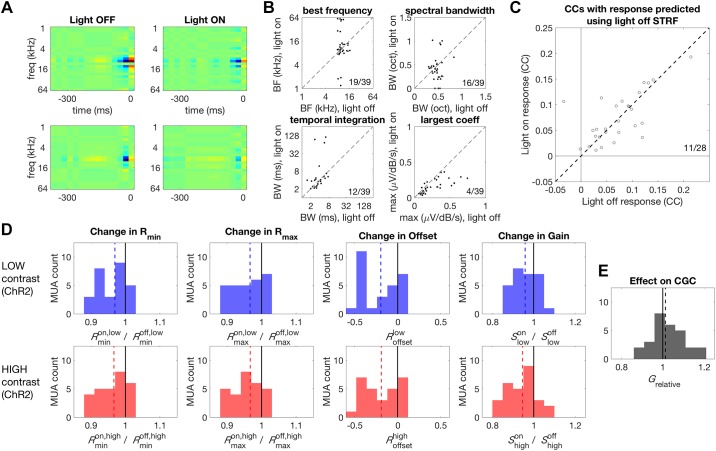Fig. 7.
Effect of PVI activation on STRF shape. A, left: two example STRFs estimated for the light-off condition. Spectrotemporal features that increase the MUA amplitude are shown in warmer colors while suppressive features are shown in cooler colors. Right: STRFs estimated for the same MUs as in left panels but under light-on conditions, during ChR2-mediated PVI activation. Color scaling is the same as for the left panels. This manipulation results in suppression of STRF coefficients, but STRF shapes are largely the same under both light-off and light-on conditions. B: comparison of STRF parameters under light-off (abscissa) versus light-on (ordinate) conditions. We observed no significant changes in best frequency, spectral bandwidth, or temporal integration window. The largest STRF coefficients were significantly reduced during PVI activation. C: predictive performance of STRFs across light conditions. STRFs fitted under light-off conditions predicted responses under light-on and light-off conditions equally well, indicating that tuning was largely unaffected by PVI activation. D: effect of PVI activation on auditory cortex responses. A reduction in baseline activity (Rmin) was produced by PVI activation during low and high-contrast stimulation (first column). A comparable reduction in the maximum response (Rmax) was also observed (second column). PVI activation produced a subtractive change in the offset of responses (third column). A reduction in gain was also observed during PVI activation (fourth column). E: PVI activation increased the strength of contrast gain control. BF, best frequency; BW, bandwidth; CCs, correlation coefficients; CGC, contrast gain control; ChR2, channelrhodopsin; Grelative, relative gain change (between conditions); MU, multiunit; MUA, MU activity; PVI, parvalbumin-positive interneurons; Rmin; 5th percentile of the response of the multiunit activity; Rmax, maximum response as the 95th percentile; S, range of responses in a particular light condition (“on” vs. “off”) and contrast condition (“low” vs. “high”); STRF, spectrotemporal receptive fields.

